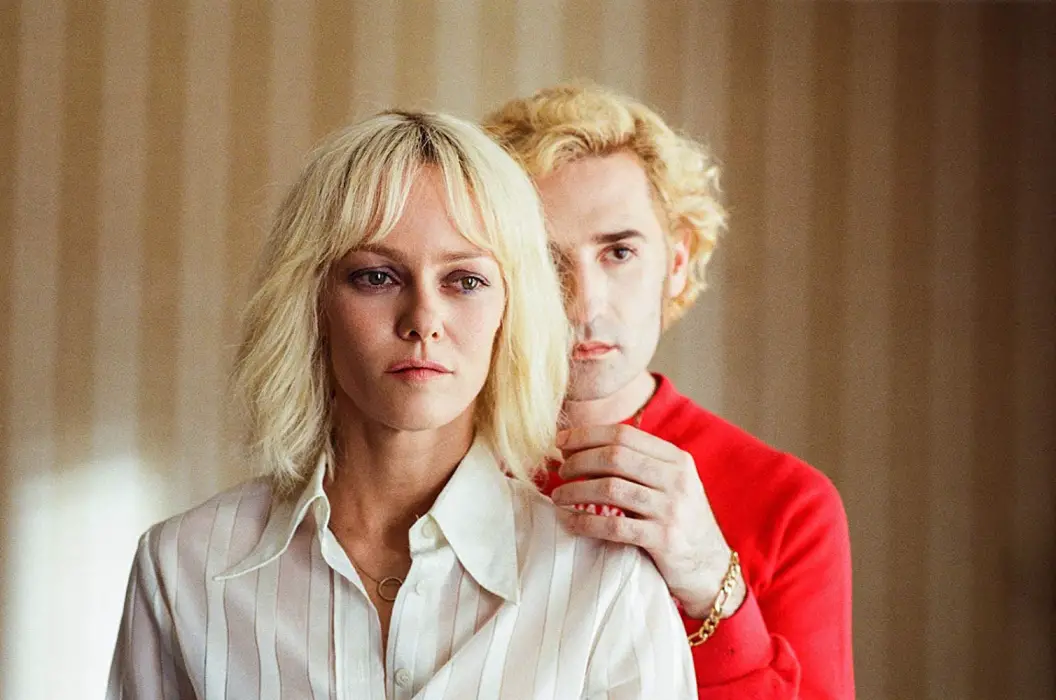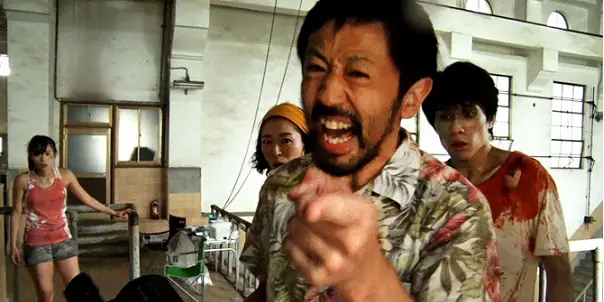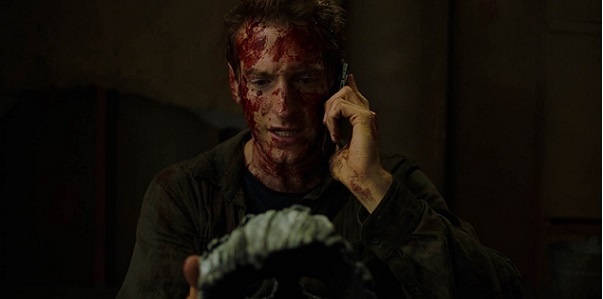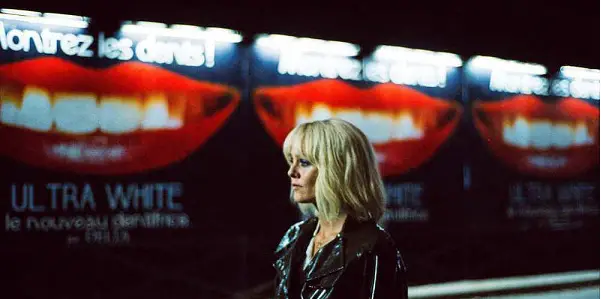Fantastic Fest 2018 Report 1: ONE CUT OF THE DEAD, YOU MIGHT BE THE KILLER & KNIFE + HEART

Hazem Fahmy is a poet and critic from Cairo. He…
One Cut of the Dead (Shin’ichirô Ueda)

It’s truly a joy to come across a film that absolutely requires being watched cold. Just as soon as you think you’ve identified what it is, what it’s trying to do, you get bamboozled. Do yourself a favor and don’t watch a trailer for One Cut of the Dead. Don’t look at more stills than you have to. In fact, don’t even read that much about it – with the exception of this review, of course. Trust me, you will have a better day –even a week– for it.
Describing this film without giving away what makes it so singular in its vision and effective in its craft is tremendously difficult. The first act is dedicated to immersing the audience in a fiction of what they think the film will be, only to pull the rug right from under their feet and laugh at them as they scratch their heads trying to figure out how they did not see that coming. Such drastic twists are tricky, especially so early on in a film. It’s easy to turn such a subversive plot device as a formulaic gimmick, but director Shin’ichirô Ueda is more than up to the challenge.
The advertised plot is simple. The crew of a low-budget Japanese zombie flick are shooting in an abandoned and isolated warehouse somewhere. In between takes, they start noticing strange things happening around them. To their shock, they discover that zombies are quickly starting to show up around them. As the set descends into panic, the Hitchc*ckian director attempts to assert his tyranny over the cast members even as they are attacked and killed, insisting that the cameraman shoot everything. But no sooner than we think we’ve adjusted to this madness, everything changes.
In both pre and post twist, Ueda’s camera is meticulously observant. He fixates on his characters habits and quirks, giving a rich insight into every member of the main cast. One of the best things about watching this film unfold (before folding and unfolding again) is relishing the pure joy with which everyone involved performs. One knows a labor of love when he sees it, and Ueda has nothing if not love for horror filmmaking.
Without giving away too much, it suffices to say that joy (believe it or not) is the operative term throughout this film. Ueda’s ode to horror filmmaking celebrates the rush and chaos of working on a set with a low budget, especially when elaborate and creative special effects are needed. Without ever being condescending, the film pokes fun at the decisions and tropes that economically marginalized filmmakers often have to rely on, but it does so in thoroughly celebratory way.
Ueda’s bending of tone and style eludes conventional genre classifications, but all the elements mesh fantastically and coherently together. In fact, the film constantly oscillates between an over-the-top performativity (that’s endearingly hilarious) and a genuine vulnerability that pushes forward the surprising emotional core. The cast, especially Takayuki Hamatsu and Yuzuki Akiyama, are exceptionally adept at this kind of shifting, and now precisely when to mine it for comedy and when for emotionality.
It’s also just so refreshing to see a film so meta in its narrative and themes actually make effective use of that self-awareness. Rather than being used as a mere shtick, the film’s consistent self-referential nature harkens back to Japanese V-Cinema aesthetics, while maintaining the utmost respect for its characters and the subject(s) of its ode.
You Might Be The Killer (Brett Simmons)

It’s hard to pull off a good horror spoof. If it doesn’t reach Shaun of the Dead levels, it usually falls flat on its face. Consider the Scary Movie franchise, which was finally and mercifully put to rest in 2013 with the fifth –dear God let it be last– installment. Horror, and especially slasher, films are really easy to make fun of. But if one doesn’t actually have much to say, the spoof can easily become little more than a regurgitation of tropes. By their very nature, clichés lend themselves to mockery and mockery is nothing new to slasher films. Though You Might Be the Killer does try a somewhat novel take on the slasher spoof, an unpolished script and a lack of substance keep it from being anything memorable.
The film’s lost potential is evident from the get go. After a hilarious cold opening in which Sam (Fran Kranz) bursts through the woods of a generic summer camp, drenched in blood. Screaming, he runs towards a cabin, fortifies himself and turns on his phone. But instead of the cops, he calls his pop culture savvy best friend, Chuck (Alyson Hannigan) for advice on how to survive the horror film he is living through.
Corny as the premise is, it starts off well enough, but quickly devolves into formulaic and mediocre comedy. The film’s methodical deconstruction of slasher tropes quickly proves mechanical. It doesn’t take long for the film to become little more than a laundry list of film tropes as writer-director Brett Simmons systematically goes through them. It’s simply lazy and uninspired. Simmons uses the audience’s familiarity with slasher dynamics as a crutch, rather than an entry point to any kind of interesting interrogation of the genre let alone its social or aesthetic implications.
By the time starts recounting the first day of camp, expressed via a flashback to an utterly forgettable motley crew Sam assembles to take care of the camp for the summer, it becomes clear that Simmons was going for Scream meets Wet Hot American Summer. It’s an ambitious combo, and a sound concept, but sadly he ignores everything that made those films the cultural landmarks they are today. Aside from their innovation, in relation to what they were spoofing (slasher films and summer camps respectively) both capitalized on their in depth understanding of the widespread tropes of their respective subjects to playfully expose their absurdity while affirming why it is so many of us are attached to them in the first place. In contrast, You Might Be the Killer falls right into the problematic and uninspired geek trap of equating pure reference with intelligence.
Unsurprisingly, characters completely conform to the logic and expectations of slasher archetypes. This in itself is not necessarily a problem, especially in parody which by no means has to be substantially critical of its subject, but it does fail when the script doesn’t actually put in the work of either subverting these tropes or even just taking advantage of them for comic effects. We spend far, far too much time with Sam who is neither compelling as a character nor very funny as the designated bumbling idiot. Kranz does what he can, but there isn’t really much an actor, even a talented one, can do with Sam, who is at best completely passive, and at worst, a downright nuisance that’s not even fun to watch. For the most part, he’s sort of just there.
Speaking of folks who’re just there, it pains me to say that Alyson Hannigan feels completely uncommitted to her role as the audience stand-in for Sam’s misfortunes. Granted, this absolutely has to do with the queasily unsubtle nature of her lines, but it’s also clear that she was just cruising through them, without even resorting to the signature charm that’s defined her most iconic roles. It also doesn’t help that the film never really gets its balance between the horror and comic elements right, so much of her rhetoric and motivation feels both confusing and frustrating.
Even when the script attempts innovation, it feels like Simmons isn’t giving everything he’s got. The non-linear structure of the narrative, where Sam recounts what he remembers to Chuck to try and piece things together, is competent at first, but it’s never quite used to its full capacity. This film is cursed by its fervent adherence to simplistic structures and it shows in the shoddy pacing. Chuck asks Sam who’s dead. Sam gets a flashback of finding that person dead. Then gradually, Sam remembers how that person died. It doesn’t allow for very memorable moments and it’s just plain boring. If nothing else, I hope You Might Be the Killer will dissuade young, bright-eyed filmmakers, who think that all you need to stand out in this medium is a working knowledge of pop culture. It’s really not enough.
Knife + Heart (Yann Gonzalez)

One of the major pitfalls of mainstream queer cinema, and especially the American variety, is the constant attempt to sanitize and simplify the histories and experiences of queer communities. Even good-intentioned films of this nature often write themselves into a corner of essentialisms, robbing queer people of their agency and complexity. It is against this machine that Yann Gonzalez’s ethereal and disturbing Knife + Heart rages.
To say that this film is an uncomfortable and challenging experience is an understatement. It confronts the audience with as much comedy as violence, frequently wading into deeply troubling territory, from sexual assault to visceral anti-queer brutality, that our culture is still figuring out exactly how to address. But rest assured, Gonzalez is no mere provocateur. He doesn’t do it just to push buttons, rather to alienate the audience from our normative and often reductive perspectives on these matters. I have no doubt that many people will deeply dislike this film for that reason, and I would not judge them in the slightest for that, but I also hope that they not simply dismiss Knife + Heart for it.
The ambitious tale opens in Paris in the late Seventies, and follows Anna (a razor-focused Vanessa Paradis) who’s ten year relationship with her lover, Lois (Kate Moran) has just ended, leaving her devastated and deeply confused. Anna is a low-budget gay-porn producer who’s in the market at just the right time and place. In her spare time, she scouts streets and construction sites, looking for husky young men to join her company, a well-oiled machine that churns out one erotic masterpiece after the other. However, the mood on her set takes a turn when a mysterious, masked killer begins murdering her actors one by one. Things swiftly get more twisted and upsetting from there.
From the start, Gonzalez makes two controversial choices. The first simply being to write a story about young gay men being brutally murdered, and I mean that in every sense of the phrase. Mainstream media already desensitizes us to violence against marginalized bodies, so it’s always tricky to portray said violence without furthering that normalization. The second decision is to center the film on Anna, an absolute monster of a person. Terrifyingly narcissistic and abusive, Anna seems to have no capacity for compassion for those around her. Even worse, the scarce moments in which she does acknowledge the pain of others swiftly turn into cash-grabbing self-service. This toxic habit is particularly pronounced when she starts making pornos based off of the murders of her very cast. Throughout the film, all this unfolds from her perspective.
However, I must emphasize again that none of this is done for the sheer shock value, and Gonzalez displays incredible nuance and awareness in his handling of these issues. The film is far from delicate, given how graphic its physical and sexual violence is, but it also doesn’t let any of these instances pass by unaddressed. At the core of the story is a haunting parable about the cyclical nature of trauma and the existential violence of callous appropriation.
What is perhaps most impressive, is Gonzalez’s ability to juggle all these considerations and interrogations while staying tightly focused on what he is actually trying to critique. His indictment of Anna’s filmography has absolutely nothing to do with porn itself, but is rather solely focused on her exploitative practices, her relentless capacity to objectify both bodies and traumas. Furthermore, his depiction of violence within the film’s queer community steers completely clear of any problematic tropes commonly used to depict queer people as “unstable” or “debased.” In fact, the opposite is true. By focusing on relationships, toxic and otherwise, within a queer community, Gonzalez imbues his character with an agency and individuality that are shamefully rare in mainstream queer cinema.
Of course, none of these themes are absent from a larger critique and examination of how society, and especially the government, render queer bodies disposable. Anna and the cast’s interactions with the police highlight this without sliding into simplistic didacticism. For better or worse, Gonzalez trusts the audience’s judgment and politics. Though his own views are always laid out in the text, he also expects his audience to know an abuser when they see one, to find empathy for those society has devastatingly let down.
The film’s substance is generously complemented by its slick and mesmerizing style. It oozes with panache from the get-go, taking full advantage of its 35mm cinematography to capture the grime and glamor of 1979’s queer Parisian underground. A bold color palette of gorgeously contrasting hues, most notably neon reds paired with deep, saturated blues, evokes the film’s internal struggle between grace, melancholy and brutality. This all comes together particularly well in an epic night club sequence that intercuts between a splendidly choreographed dance and a grisly murder. Gonzalez brings out the cinema in both.
Does content like this matter to you?
Become a Member and support film journalism. Unlock access to all of Film Inquiry`s great articles. Join a community of like-minded readers who are passionate about cinema - get access to our private members Network, give back to independent filmmakers, and more.
Hazem Fahmy is a poet and critic from Cairo. He is an Honors graduate of Wesleyan University’s College of Letters where he studied literature, philosophy, history and film. His work has appeared, or is forthcoming in Apogee, HEArt, Mizna, and The Offing. In his spare time, Hazem writes about the Middle East and tries to come up with creative ways to mock Classicism. He makes videos occasionally.













